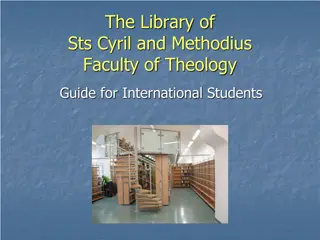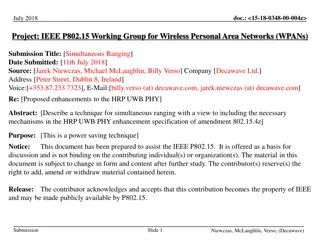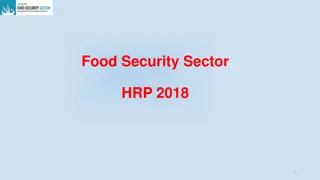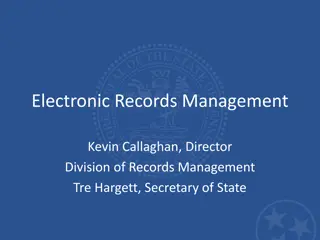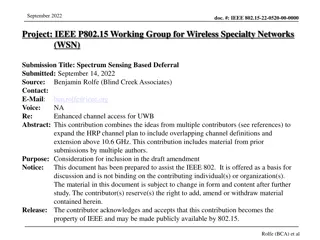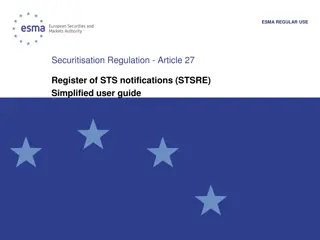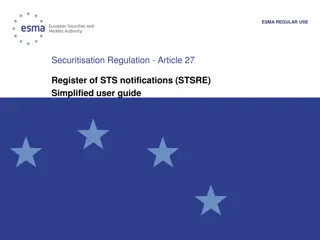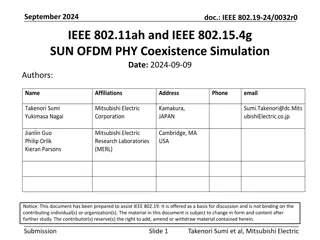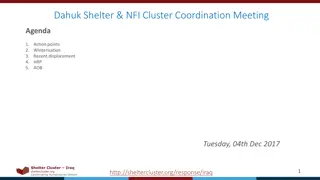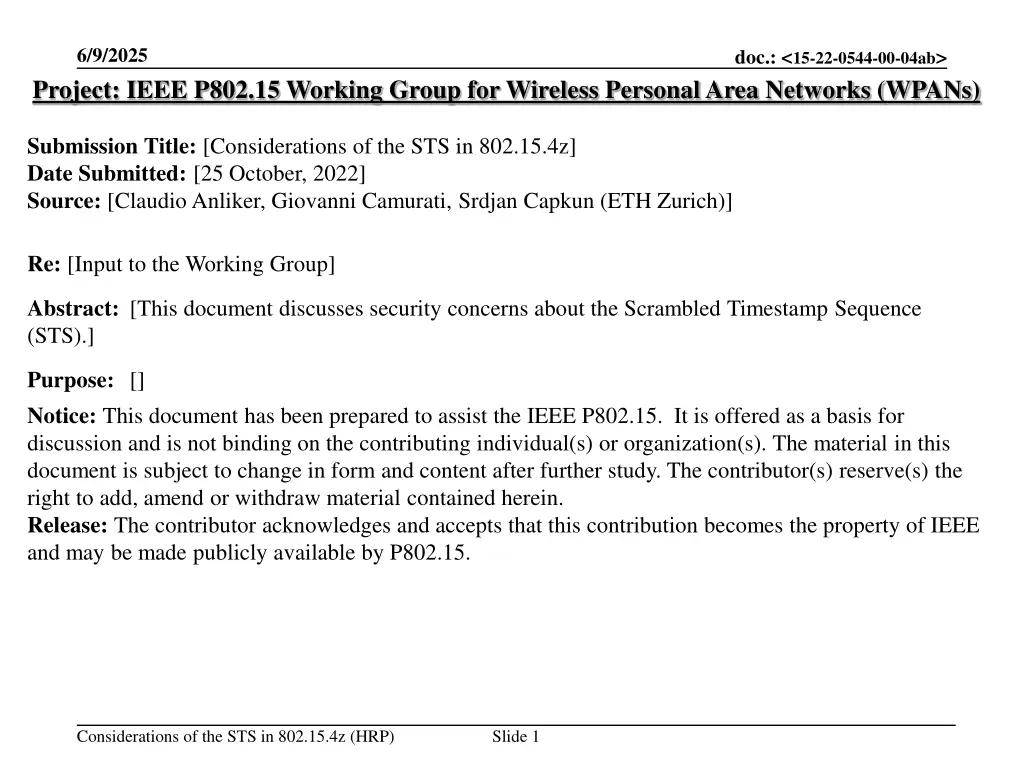
Security Concerns of Scrambled Timestamp Sequence in IEEE 802.15.4z
Explore the security considerations surrounding the Scrambled Timestamp Sequence (STS) in IEEE 802.15.4z, addressing potential vulnerabilities and proposed solutions to enhance network security and integrity.
Download Presentation

Please find below an Image/Link to download the presentation.
The content on the website is provided AS IS for your information and personal use only. It may not be sold, licensed, or shared on other websites without obtaining consent from the author. If you encounter any issues during the download, it is possible that the publisher has removed the file from their server.
You are allowed to download the files provided on this website for personal or commercial use, subject to the condition that they are used lawfully. All files are the property of their respective owners.
The content on the website is provided AS IS for your information and personal use only. It may not be sold, licensed, or shared on other websites without obtaining consent from the author.
E N D
Presentation Transcript
6/9/2025 doc.: <15-22-0544-00-04ab> Project: IEEE P802.15 Working Group for Wireless Personal Area Networks (WPANs) Submission Title: [Considerations of the STS in 802.15.4z] Date Submitted: [25 October, 2022] Source: [Claudio Anliker, Giovanni Camurati, Srdjan Capkun (ETH Zurich)] Re: [Input to the Working Group] Abstract: [This document discusses security concerns about the Scrambled Timestamp Sequence (STS).] Purpose: [] Notice: This document has been prepared to assist the IEEE P802.15. It is offered as a basis for discussion and is not binding on the contributing individual(s) or organization(s). The material in this document is subject to change in form and content after further study. The contributor(s) reserve(s) the right to add, amend or withdraw material contained herein. Release: The contributor acknowledges and accepts that this contribution becomes the property of IEEE and may be made publicly available by P802.15. Considerations of the STS in 802.15.4z (HRP) Slide 1
6/9/2025 doc.: <15-22-0544-00-04ab> PAR Objective Safeguards so that the high throughput data use cases will not cause significant disruption to low duty-cycle ranging use cases Interference mitigation techniques to support higher density and higher traffic use cases Other coexistence improvement Backward compatibility with enhanced ranging capable devices (ERDEVs) Improved link budget and/or reduced air-time Additional channels and operating frequencies Improvements to accuracy / precision / reliability and interoperability for high-integrity ranging Reduced complexity and power consumption Hybrid operation with narrowband signaling to assist UWB Enhanced native discovery and connection setup mechanisms Sensing capabilities to support presence detection and environment mapping Low-power low-latency streaming Higher data-rate streaming allowing at least 50 Mbit/s of throughput Support for peer-to-peer, peer-to-multi-peer, and station-to- infrastructure protocols Infrastructure synchronization mechanisms Proposed Solution (how addressed) Consider STS alternatives for 4ab. Considerations of the STS in 802.15.4z (HRP) Slide 2
6/9/2025 doc.: <15-22-0544-00-04ab> Clarifications on the Ghost Peak paper Simple Attack on static STS / Super Deterministic Code (SDC): reduced ToF due to earlier ToA compute ToF Initiator ???1 ???1 Attacker and retransmit it earlier! can learn STS Responder scheduled response time The attacker can learn the STS and use it to advance the signal in time distance reduction. This is not the Ghost Peak attack. Considerations of the STS in 802.15.4z (HRP) Slide 3
6/9/2025 doc.: <15-22-0544-00-04ab> Clarifications on the Ghost Peak paper Ghost Peak: oblivious to STS content: shorter ToF due to Ghost Peak compute ToF Initiator ????+1 ????+1+ ?????? ???? Attacker transmit a randomly chosen ?????? instead not interested in ???? Responder scheduled response time The Ghost Peak attacker does not bother to learn the STS: GP is designed to attack the dynamic STS mode, where learning the STS is pointless. Works against the static STS too, but more effective attacks are available (see previous slide). Considerations of the STS in 802.15.4z (HRP) Slide 4
6/9/2025 doc.: <15-22-0544-00-04ab> Clarifications on the Ghost Peak paper Major points: We observed distance reductions with chips of two vendors using DS-TWR, 64/128 block STS (4/8k pulses) and dynamic STS mode. The success probabilities for the two chips were ~4% and ~0.02%, respectively. The difference may depend to some degree on fine tuning / calibration of the setup, STS length, and receiver internals. The maximal distance reductions were ~15-20m (not controllable). Considerations of the STS in 802.15.4z (HRP) Slide 5
6/9/2025 doc.: <15-22-0544-00-04ab> Recap: STS The STS consists of pseudo-random bits (4096 in standard configuration): Generated with AES Every bit is represented by a single pulse. However, these bits are not decoded / recovered by the receiver. In HRP, the high Pulse-Repetition Frequency (PRF) makes it difficult to decode individual pulses. Example: Pulse interval of e.g. 16 ns, channel spread of 100 ns realistic overlap of several pulses Result: Received signal is heavily distorted by the channel, BER would be high Consequence: Perform cross-correlation between received signal and STS to measure similarity between them at any given time. Considerations of the STS in 802.15.4z (HRP) Slide 6
6/9/2025 doc.: <15-22-0544-00-04ab> Recap: STS TX Result of cross-correlation of a received signal (? ? ) with a known STS (????? ) results in a Channel Impulse Response (CIR) approximation: A peak indicates that a copy of the STS arrived at that point in time. Intuition: since the attacker does not know the STS, they cannot create such a peak. Thus, one can use the first peak in the STS CIR to securely determine the ToA of the ranging message. RX Considerations of the STS in 802.15.4z (HRP) Slide 7
6/9/2025 doc.: <15-22-0544-00-04ab> CIR example = Considerations of the STS in 802.15.4z (HRP) Slide 8
6/9/2025 doc.: <15-22-0544-00-04ab> CIR example similarities auto-correlation channel spread inter-pulse interference Considerations of the STS in 802.15.4z (HRP) Slide 9
6/9/2025 doc.: <15-22-0544-00-04ab> CIR example CIR improved, but there is still noise. Threshold to identify peaks. Considerations of the STS in 802.15.4z (HRP) Slide 10
6/9/2025 doc.: <15-22-0544-00-04ab> CIR example What happens if an attacker injects a signal? Ghost Peak The injected signal raises the noise floor of the CIR. If a value within the backsearch window exceeds the threshold, the attack is successful. Considerations of the STS in 802.15.4z (HRP) Slide 11
6/9/2025 doc.: <15-22-0544-00-04ab> Summary CIR There is no bit decoding: Each CIR value depends on ???? different samples: The CIR value only shows the overall correlation result, not how it has been obtained. A single correlation value does not accurately reflect the number of correct bits. Compare: Largely correct but attenuated copy of STS Injected signal with a few (slightly more than 50%) correct pulses with high power However, a strong, incorrect signal injection increases the correlation noise: Thus, the statistical significance of a peak compared to the noise is used. Considerations of the STS in 802.15.4z (HRP) Slide 12
6/9/2025 doc.: <15-22-0544-00-04ab> Open questions / issues How does the noise floor have to be calculated? By how much does a correlation value have to be above the noise to be regarded as a peak? Or, in other words: how strong does a genuine path have to be for us to guarantee its security? Since CIR values depend on the power of individual pulses, a security analysis likely depends on receiver design/parameters, such as the Automatic Gain Control (AGC), the resolution of the Analog-to-Digital Converter (ADC), and clipping of high-power signals, as they all affect the set of possible inputs for the CIR computation. Considerations of the STS in 802.15.4z (HRP) Slide 13
6/9/2025 doc.: <15-22-0544-00-04ab> Open questions / issues Consequence: The security properties of the STS are unclear and probably hard to prove, depend on the receiver implementation, and likely require additional hardening measures / defense mechanisms, which are not standardized. No security guarantees or public analysis, customers and chip integrators have to trust vendors. Decide whether UWB security should be a matter of standardization or competition. Alternative security approach preferable for IEEE 802.15.4ab Decouple security properties from receiver design to encourage open discussion / collaboration Individual bit decoding (similar to LRP) for the RIF? Considerations of the STS in 802.15.4z (HRP) Slide 14
6/9/2025 doc.: <15-22-0544-00-04ab> Questions? Takeaways Ghost Peak successful against static and dynamic STS modes of chips of at least two vendors. Auto-correlation noise and inter-pulse interference lead to noisy CIR Receivers use a threshold (or other strategy?) to distinguish CIR noise from legitimate paths This is not standardized, receiver-specific and, in some cases, demonstrably insecure in practice. Considerations of the STS in 802.15.4z (HRP) Slide 15







